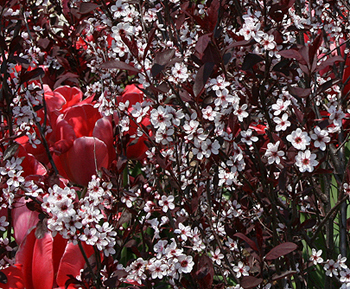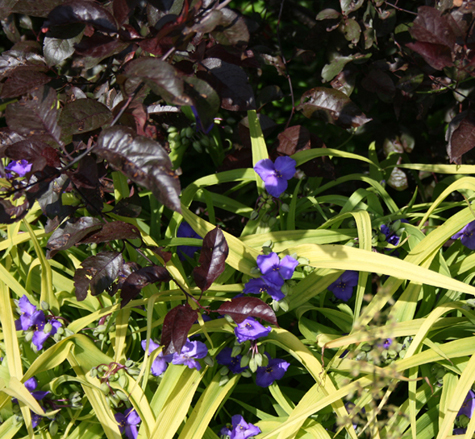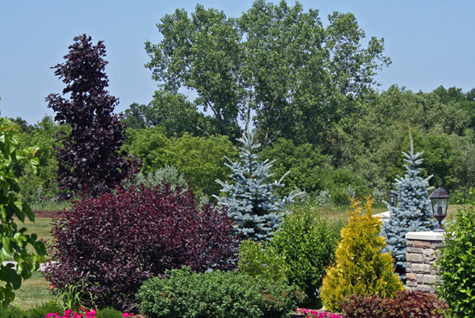Height: 2 m (7 feet)
Spread: 1.5 m (5 feet)
Bloom: Small white flowers in spring
Exposure: Full sun to part shade
Foliage: blackish-purple, new growth red-purple
Pluses: foliage colour
Cons: Japanese beetle damage
When we first moved to our yard there were 16 Purpleleaf Sand Cherry spread throughout my gardens. With it’s rich reddish-purple foliage, the repetition of both colour and shape brought a sense of unity to my overall garden design. Prunus cistena will grow in most soils with little care except regular pruning. It is a fast grower and can reach more than 10 feet if left totally alone. Some pruning is advisable however as the branches can split when older. Purpleleaf Sand Cherry responds well to many types of pruning including coppicing and renewal pruning.
 Prunus x cistena can make a great hedge, specimen plant or mass planting. Flowers are pale pink with a darker centre, are slightly fragrant and appear in early spring.
Prunus x cistena can make a great hedge, specimen plant or mass planting. Flowers are pale pink with a darker centre, are slightly fragrant and appear in early spring.
I grow Purpleleaf Sand Cherry mainly for it’s foliage colour. It’s colour starts out a vivid red-purple fading to a deeper black-purple by mid-summer. A slight pruning in mid-summer will encourage new brighter growth. In order to keep the new foliage growth as vivid as possible I prune out up to 1/3 of the old growth regularly each spring.
Colour contrasts can also be achieved solely with the use of shrubs selected for their colourful foliage. Consider Purpleleaf Sand Cherry if you do not have Japanese Beetles as a great addition to the garden.
The only downside of Prunus x cistena is it’s susceptibility to the Japanese Beetle. In a bad year they can completely strip the new foliage. I have taken a couple of steps to controlling Japanese Beetle damage in my yard:
1. Replacing susceptible trees and shrubs with more resistant varieties. In particular I have replaced many of the Purple Sand Cherries in my yard with Coppertina Ninebark. This has allowed me to maintain the cohesiveness of purple foliage throughout my gardens but with less pest damage.
2. I keep the remaining Purpleleaf Sand Cherries in my yard on the small side with regular pruning and then walk the garden during the worst Japanese Beetle infestation periods each morning and evening knocking them off of the plants into a bucket of soapy water.
Garden Location: As of 2011 I have 7 remaining Sand Cherries all in the Entrance Gardens and at the top of the driveway.


Hi, I love your combination of plants in the picture above; I wonder if you would be able to tell me what the other shrubs/plants are in the picture. It’s lovely and looks like what I’ve been trying to achieve, but not finding the right shrubs/plants.
Thanks!
Hi Colette. The evergreens are blue spruce (although they are much taller now). The yellow cedar is Yellow Ribbon Cedar (Thuja occidentalis) – again much taller now, the low green shrubs are Spirea bumalda “Thor’. The larger green shrubs are a Rose of Sharon (now gone since the ever greens have grown) and Clethra alnifolia ‘Ruby Spice’ although it too doesn’t show as much anymore. Hope that helps but basically if you mix yellows, blues with purple & some darker greens it will work. The groundcovers are petunias and old purple coral bells.